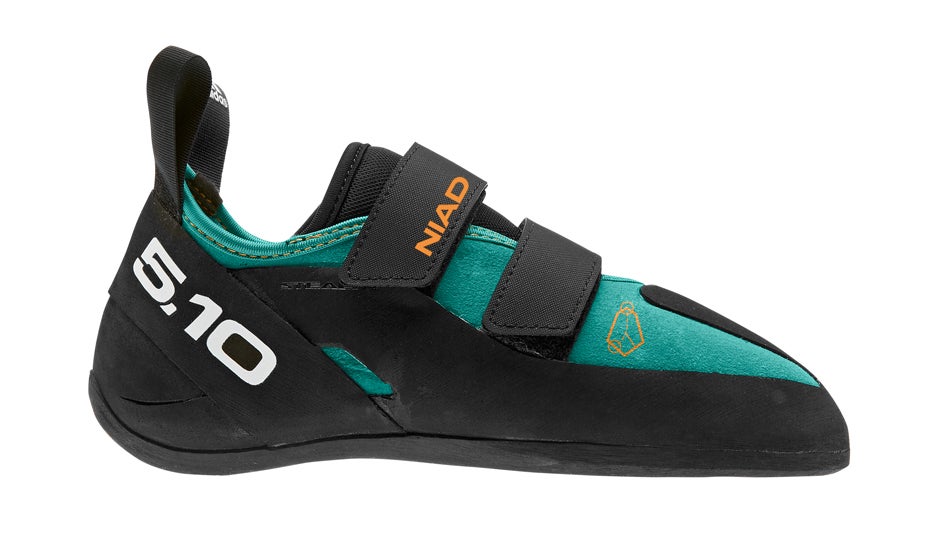Review: Five Ten NIAD VCS

"None"

My earliest memory from devouring climbing magazines during my youth is a Jim Thornburg image of Chris Sharma in 1997, then age 15, stretched out for a shallow edge on Necessary Evil (5.14c) in Arizona’s Virgin River Gorge. On his feet were tan Five Ten Anasazi Velcro shoes. Chris is powering out every last millimeter of rubber on his backstepped left foot, his right foot driving hard into his big toe.
Since 1992, the Anasazi line has remained mostly unchanged, with gym climbers, boulderers, sport climbers, and trad climbers flocking to these all-arounders for their precision, comfort, and support. The brainchild of founder Charles Cole, the iconic line includes soft slippers, mid-stiff Velcros, and rigid Lace-Ups with an asymmetrical toebox. This year, Five Ten updated and rebranded the Anasazi line as the NIAD line: the NIAD VCS, which I tested, and coming in March, the Lace-Up model ($150) and a Moccasym slipper (Mocc; $125). Both the VCS and Lace-Up will have women’s models, but the Mocc will only come in men’s sizing. The NIAD acronym is short for Nose in a Day, fitting as the company’s roots are in Yosemite climbing. This is where Cole (1955–2018) tested the “world’s stickiest rubber,” C4, on his new line of climbing and approach shoes.
I tested the NIAD VCS in the Sierra Foothills and Yosemite Valley this winter. The results were impressive: The flat-lasted (neutral) sole excelled on thin seams and vertical to gently overhanging faces. The chiseled toe design was precise enough to stand on small nubbins and powerful enough to smudge steep edges, while additional support came from heel tension (slingshot rand) that pushed my toes into the toebox. And reliable friction came from the 3.5mm C4 rubber on the soles.
Because the shoe drives so much power over the front of the toe, I found myself climbing more on my tippy-toes, making my feet skate as I got used to the shoes. Once I broke them in, however, and when on the steeps, the VCS’s didn’t slip at all. As I quickly learned, the sweet spot for powering off edges was right in the front-middle of the toe. (The one downside to all that big-toe power was that I rounded the tip of the sole, likely from climbing coarse granite slabs, though I didn’t notice a subsequent dip in performance.) This was helpful on gently overhanging sport lines like Coup d’Etat (5.12a) at Yosemite’s USGS Wall, where the toe gripped sloping dime edges.

The NIAD’s unlined uppers are constructed of high-comfort, low-stretch suede microfiber that is breathable and abrasion-resistant. Over many days of bouldering, sport climbing, and trad, my feet didn’t get sweaty or overheat, and the uppers still look out-of-the-box new. A final aesthetic change is an interior with a topo design of the Nose. For fit, the two generously sized Velcro straps locked the shoes over my feet and offered enough width options to allow me to crank them down for a secure fit on my wide feet. I liked how the Velcro straps wrapped horizontally from the base of the ankle to midway across my foot and not over my massive bunion. For a comfortable all-day fit, I got them in the same size as my street shoes. There’s also a new non-stretch stiffener that forms to the front of the shoe inside the footbed. It’s soft-to-the-touch material that is comfortable underfoot.Meanwhile, the Lace-Up and VCS have full-length stiff, yet flexible midsoles made of synthetic material and stiffening TPU laminate; the Moccs have a soft midsole.
Sliding my feet into the NIADs brought back a wave of memories from past climbs, but gone were the annoyances that had previously plagued the Lace-Up and Velcro Anasazis for me, including the notorious Achilles-tendon pinch. For the redesigned heel, “we separated the heelcup from the slingshot to get a form-fitting 3D shape,” product manager Jakob Krauss wrote in an email. The redesign was comfortable and didn’t leave dead space in the heel—the new heelcup gently wrapped my Achilles tendon and provided a snug fit that made hooking secure. When jamming cracks, I liked how additional rubber on the top-front of the uppers extending to the forefoot provided a slight cushion for my toes.
The ultimate test I set for the NIAD VCS was at Yosemite’s burly Arch Rock. Everything hard about Valley climbing is packed in here—endless cracks over stone so polished that it squeaks when you smear. I wanted to see how well they performed on Midterm, the squeakiest of the lines at Arch, a nails-hard 5.10 that begins with first-knuckle fingertip jamming with slick edges for feet. From here it widens to fingers, hands… all the way to a slick, flared chimney. That day on Midterm, my feet didn’t slip once—not on the nothing-there smears, nor on the heel-toe jams, nor on the highstep rollovers. I was amazed, and the NIADs performed flawlessly.
Pros
- Asymmetric design puts power over the big toe, making it easier to climb seams and smudge off small edges
- Heel design is secure and doesn’t pinch the Achilles tendon like past (Anasazi) models
- Breathable, synthetic uppers are abrasion resistant and soft against the skin
Cons
- Asymmetric design can make the rubber in the big-toe area round out quickly
$150, adidas.com/us/five_ten